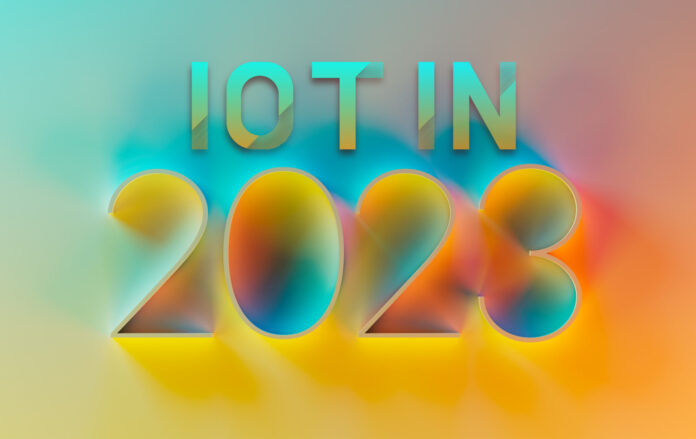Digital transformation of supply chains has solidified as a boardroom topic over the past 12 months. While this drive for industrial change can be attributed to international developments, it is also true that many companies now clearly see the benefits of adopting new digital technologies as they scrutinize their bottom line.
But many more remain on the fence, and wonder, ‘where to go from here?’ Based on insights gained over the past decade, Kristoff Van Rattinghe, chief executive at Belgium-founded IoT firm Sensolus, makes five forecasts for digitization of the supply chain in the year ahead.
#1 | DIGITIZATION IS THE ‘NEW NORMAL’

Recent global economic changes are fueling the adoption of digitization within the supply chain. In 2020, the Covid-19 pandemic caused a shockwave in global supply chain processes. In 2022, war in Ukraine, the ongoing energy crisis, and the inflation of commodity prices have all accelerated the need for data-driven insights into the supply chain. In 2023, we will also have to overcome challenges.
Industries are integrating digitization into their processes as the economic value drivers can’t be ignored. Digitization is a cost-saver, increases daily productivity, and provides more visibility and transparency to all stakeholders. There is a general awareness that supply chain digitization is the new normal. Like how phones, PCs, printers, internet, laptops, and smartphones have been adopted, IoT in ‘non-powered assets’ like transport packaging, containers and equipment cases will be normal soon. And those not stepping in will lose market share and competitiveness.
Supply chain digitization has become a strategic asset for all industries.
#2 | COMPLIANCE DRIVES INVESTMENTS
As the regulatory and contractual environment becomes more and more complex, compliance will drive more businesses to invest in digitizing non-powered assets. In all industries, industry leaders want to ensure they are making good on their promises to their customers and stakeholders. Some of these promises are legally inspired, such as temperature control on perishable goods, food and pharmaceutical products, or for instance multi-modal logistic logbooks for dangerous goods transport.
Many are contractually inspired, such as conditioning monitoring (shock/tilt) during transport, the timely delivery of goods at locations where suppliers have no access, ensuring buffer stocks of packaging to avoid penalties, or providing digital location logbooks for insurance purposes. Without any intention of a negative connotation, the industry leaders are investing to carve out the “blind spots” in their processes by digitizing the non-powered assets.
They all strive for end to end process control and compliance.
#3 | NEW ERA OF PROCESS INTELLIGENCE
‘Process intelligence’ is the name for the core value driver for industries wanting to embrace IoT technology in their processes. Since around 2015, IoT companies have focused primarily on connecting non-powered assets and creating digital twins of individual assets in a scalable, reliable, and efficient way. Digitization empowers the industry to effectively control these assets without the danger of blind spots and human error that comes with outdated, manual logging.
In 2019, the focus shifted to ‘connected processes’ – in other words, getting visibility on the processes that rely on non-powered assets. For example, by integrating connected processes, industrial equipment manufacturers gain visibility (KPIs) on the performance of packaging flows, visibility on the retention and rotation of their packaging, and receive notifications if deviations occur.
As more and more assets become connected, processes become more visible, and process intelligence can finally flourish. In essence, the data collected around these assets and processes will ultimately fuel actionable insights that will optimize processes and transform businesses. IoT has become a crucial ingredient used by analyst teams (and AI platforms) to detect patterns, forecast improvements, and invest in change. This will have a long-term strategic impact on industries leading the charge.
#4 | MATURATION AND STANDARDIZATION
The IoT industry is a jungle just because of the sheer number of different hardware providers, communication protocols, and localization technologies, alongside upcoming inventions such as energy harvesting, satellite communications, blockchains, and so much more. IoT technology is constantly evolving, and customers can easily get lost – and even invest in the wrong technology, and find themselves stuck with it for many years.
Firms that offer end-to-end accountability and function as a one-stop shop tend to perform better. But it is about more than just technology. Standardization and maturation are kicking in, with examples such as low-power cellular connectivity, Bluetooth as an industry standard, proven hardware will be available in volume, and so much more. Decision criteria have shifted beyond implementation, towards the long-term reliability of the technology.
Among those expectations: proven OEM liability, hardware supply chain continuity, cyber security readiness, and overall flexibility and guaranteed life-cycle management. With the large-scale adoption of IoT, there is a strong focus on reduction of long-term operational risk in the selection of partners. Our industry is no longer about innovation, it is driven by operational excellence and execution. In other words, the ultimate test is that solutions “just work”.
#5 | CORPORATE RESPONSIBILITY TELLS
More of a wish than a prediction. We have a life-threatening challenge in front of us – climate change. Which will make the recent pandemic and economic hiccups feel like wrinkles in a global shake-up. Digitization contributes significantly to our ability to ‘do more with less’. By creating digital twins of non-powered assets and generating process intelligence, we have the data and intelligence to reduce our environmental impact significantly.
Going green with packaging and transportation is easier than you think. For starters, single-use packaging can be swapped out for reusable options made from recycled plastics. Adoption of less-polluting multi-modal logistics, a reduction in asset losses, and a circular economy for shared non-powered assets like containers and pallets do not only benefit the bottom-line, but also offer great potential to reduce our global waste footprint.
We have a common challenge, and asset digitization is an innovation that can drive part of the transition. In 2023, when economic challenges remain, corporate responsibility can be a long-term game-changer in decision-making. The landscape is changing rapidly, and digitization – in its many forms – is more prominent. Starting 2023, it is important to plan for the future. T
IoT, Industry 4.0 / 5.0, process intelligence – these are not just some buzzwords about some future tech, but means to make change today. The future is already here.
About Sensolus
Kristoff Van Rattinghe is the CEO of Belgium-founded IoT firm Sensolus. The Ghent-based scale-up was founded in 2013 and operates in a variety of industries, from aerospace, automotive and logistics to industrial manufacturing and waste management. Customers such as Airbus, Atlas Copco and AB InBev rely on Sensolus’ IoT solution on a daily basis. More than 200,000 objects can be tracked on the platform in real time.

